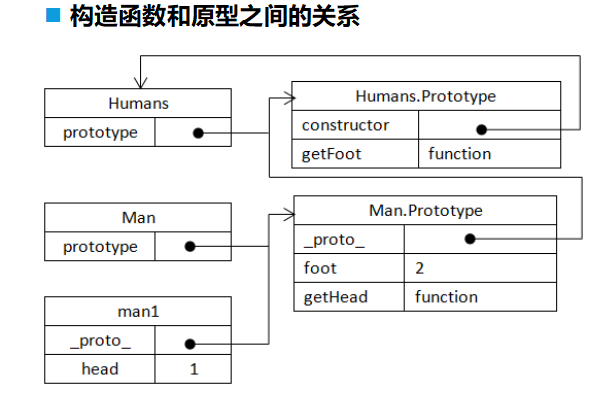
1.JavaScript中的数据类型
number(数值类型)
string(字符串类型)
boolean(布尔类型)
null(空类型)
undefined(未定义类型)
object(对象类型)
2.对象:
概念: 是包含相关属性和方法的集合体
属性
方法
3.什么是面向对象 :
面向对象仅仅是一个概念或者编程思想
通过一种叫做原型的方式来实现面向对象编程
4.创建对象:
1.自定义对象
1>基于Object对象的方式创建对象
语法: var 对象名 = new Object() ;
实例:
var person=new Object(); person.name="小明";
person.sex="男";
person.age=18;
person.hobby="看书、看电影、健身、购物等";
person.showName=function(){
alert(this.name); }
person.showName();
2>使用字面量赋值方式创建对象
实例:
var person={
name:"小明",
sex:"男",
age:18,
hobby:"看书、看电影、健身、购物等",
showName:function(){
alert(this.name);}
}
person.showName();
2.内置对象
1.String(字符串)对象
length属性
indexOf()方法 , replace()方法
2.Date(日期)对象
get*** : 获取年,月,日,时,分,秒等等
set*** : 设置年,月,日,时,分,秒等等
3.Array(数组)对象
length事项
sort() , concat() , join() 方法
4.Boolean(逻辑)对象
true 或者 false
toString()方法
5.Math(算术)对象
round() , max() , min()方法
6.RegExp对象
RegExp是正则表达式的缩写
5.构造函数和原型对象(用来解决使用同一个接口不需要创建很多对象,减少产生大量的重复代码)
1.构造函数: (始终都应该以一个大写字母开头)
1.创建指定类型的对象
2.通过this变量来控制属性和方法 , 实现属性和方法的调用
3.通过new操作符来创建对应的构造函数的实例,也就是对象
实例:
function person(name,sex,age,hobby){
this.name=name;
this.sex=sex;
this.age=age;
this.hobby=hobby;
this.showName=function(){
alert(this.name);
}
}
var person1=new person("小明","男",18,"看书");
person1.showName();
var person2=new person("小南","男",18,"看尤香");
person2.showName();
var person3=new person("小北","男",18,"看电影");
person3.showName();
调用构造函数的四个步骤
1.创建一个新对象
2.将构造函数的作用域赋给新对象(this)
3.执行构造函数中的代码
4.返回新对象
constructor属性 指向Person
实例:
alert(person1.constructor==Person);
alert(person2.constructor==Person);
alert(person3.constructor==Person);
instanceof操作符 检测对象类型
实例:
alert(person1 instanceof Object);
alert(person1 instanceof Person);
alert(person2 instanceof Object);
alert(person2 instanceof Person);
alert(person3 instanceof Object);
alert(person3 instanceof Person);
2.原型对象:
1.每一个函数都有一个prototype属性 , 这个属性是一个指针. 指向一个对象
2.prototype就是通过构造函数而创建的那个对象实例的原型对象
实例:
function person(){
}
person.prototype.name="小明";
person.prototype.sex="男";
person.prototype.age=18;
person.prototype.showName=function(){
alert(this.name);
}
var person1=new person();
var person2=new person();
person1.name="小花";
alert(person1.name);
alert(person2.name);
6.javascript继承 :
1.原型链
一个原型对象是另一个原型对象的实例
相关的原型对象层层递进, 就构成了实例与原型的链条, 就是原型链
实例:
function humans(){
this.foot=2;
}
humans.prototype.getfoot=function(){
return this.foot;
}
function man(){
this.head=1;
}
// man继承了humans
man.prototype=new humans();
man.prototype.gethead=function(){
return this.head;
}
var man1=new man();
alert(man1.getfoot());
alert(man1.gethead());
alert(man1 instanceof Object);
alert(man1 instanceof humans);
alert(man1 instanceof man);
构造函数和原型之间的关系:

调用man1.getFoot()经历的三个步骤
1.搜索实例
2.搜索Man.prototype
3.搜索Humans.prototype
完整的原型链:

2.对象继承
实例:
function Humans(){
this.clothing=["trousers","dress","jacket"];
}
function Man(){ }
//继承了Humans
Man.prototype=new Humans();
var man1=new Man();
man1.clothing.push("coat");
alert(man1.clothing);
var man2=new Man();
alert(man2.clothing);
7.借用构造函数:
apply : 应用某一对象的一个方法 , 用另一个对象替换当前对象
语法 : apply([thisObj [,argArray]])
call : 调用一个对象的一个方法 , 以另一个对象替换当前对象
语法: call([thisObj[,arg1[,arg2[, [,argN]]]]])
实例:
function Humans(name){
this.name=name;
}
function Man(){
Humans.call(this,"mary");//继承了Humans,同时还传递了参数
this.age=38; //实例属性
}
var man1=new Man();
alert(man1.name); //输出mary
alert(man1.age); //输出38
8.组合继承:(也叫作伪经典继承)
将原型链和借用构造函数的技术组合到一块 , 发挥二者之长的一种继承模式
使用原型链实现对原型属性和方法的继承 , 而通过借用构造函数来实现对实例属性的继承